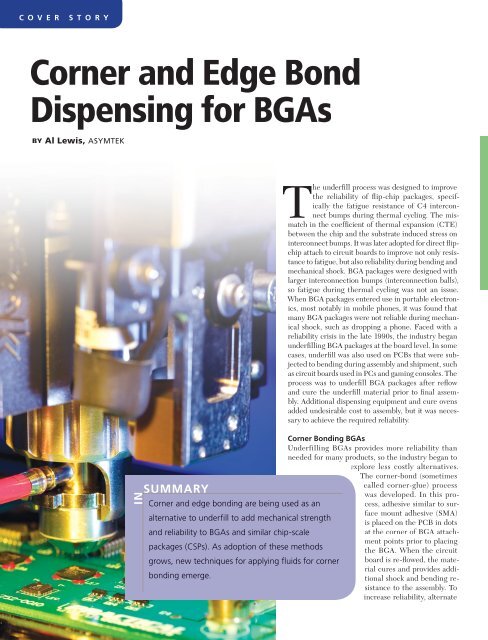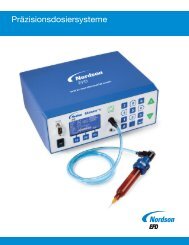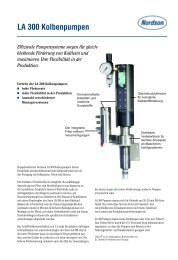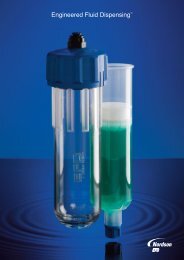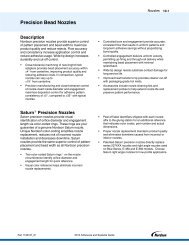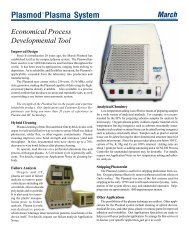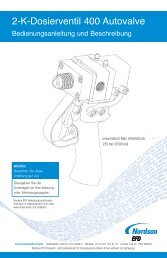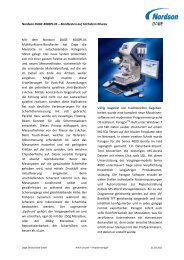Corner Bond Dispensing for BGAs - Nordson Corporation
Corner Bond Dispensing for BGAs - Nordson Corporation
Corner Bond Dispensing for BGAs - Nordson Corporation
Create successful ePaper yourself
Turn your PDF publications into a flip-book with our unique Google optimized e-Paper software.
C O V E R S T O R Y<br />
<strong>Corner</strong> and Edge <strong>Bond</strong><br />
<strong>Dispensing</strong> <strong>for</strong> <strong>BGAs</strong><br />
BY Al Lewis, ASYMTEK<br />
IN<br />
SUMMARY<br />
<strong>Corner</strong> and edge bonding are being used as an<br />
alternative to underfi ll to add mechanical strength<br />
and reliability to <strong>BGAs</strong> and similar chip-scale<br />
packages (CSPs). As adoption of these methods<br />
grows, new techniques <strong>for</strong> applying fl uids <strong>for</strong> corner<br />
bonding emerge.<br />
The underfi ll process was designed to improve<br />
the reliability of fl ip-chip packages, specifically<br />
the fatigue resistance of C4 interconnect<br />
bumps during thermal cycling. The mismatch<br />
in the coeffi cient of thermal expansion (CTE)<br />
between the chip and the substrate induced stress on<br />
interconnect bumps. It was later adopted <strong>for</strong> direct fl ipchip<br />
attach to circuit boards to improve not only resistance<br />
to fatigue, but also reliability during bending and<br />
mechanical shock. BGA packages were designed with<br />
larger interconnection bumps (interconnection balls),<br />
so fatigue during thermal cycling was not an issue.<br />
When BGA packages entered use in portable electronics,<br />
most notably in mobile phones, it was found that<br />
many BGA packages were not reliable during mechanical<br />
shock, such as dropping a phone. Faced with a<br />
reliability crisis in the late 1990s, the industry began<br />
underfi lling BGA packages at the board level. In some<br />
cases, underfi ll was also used on PCBs that were subjected<br />
to bending during assembly and shipment, such<br />
as circuit boards used in PCs and gaming consoles. The<br />
process was to underfi ll BGA packages after refl ow<br />
and cure the underfi ll material prior to fi nal assembly.<br />
Additional dispensing equipment and cure ovens<br />
added undesirable cost to assembly, but it was necessary<br />
to achieve the required reliability.<br />
<strong>Corner</strong> <strong>Bond</strong>ing <strong>BGAs</strong><br />
Underfilling <strong>BGAs</strong> provides more reliability than<br />
needed <strong>for</strong> many products, so the industry began to<br />
explore less costly alternatives.<br />
The corner-bond (sometimes<br />
called corner-glue) process<br />
was developed. In this process,<br />
adhesive similar to surface<br />
mount adhesive (SMA)<br />
is placed on the PCB in dots<br />
at the corner of BGA attachment<br />
points prior to placing<br />
the BGA. When the circuit<br />
board is re-fl owed, the material<br />
cures and provides additional<br />
shock and bending resistance<br />
to the assembly. To<br />
increase reliability, alternate


